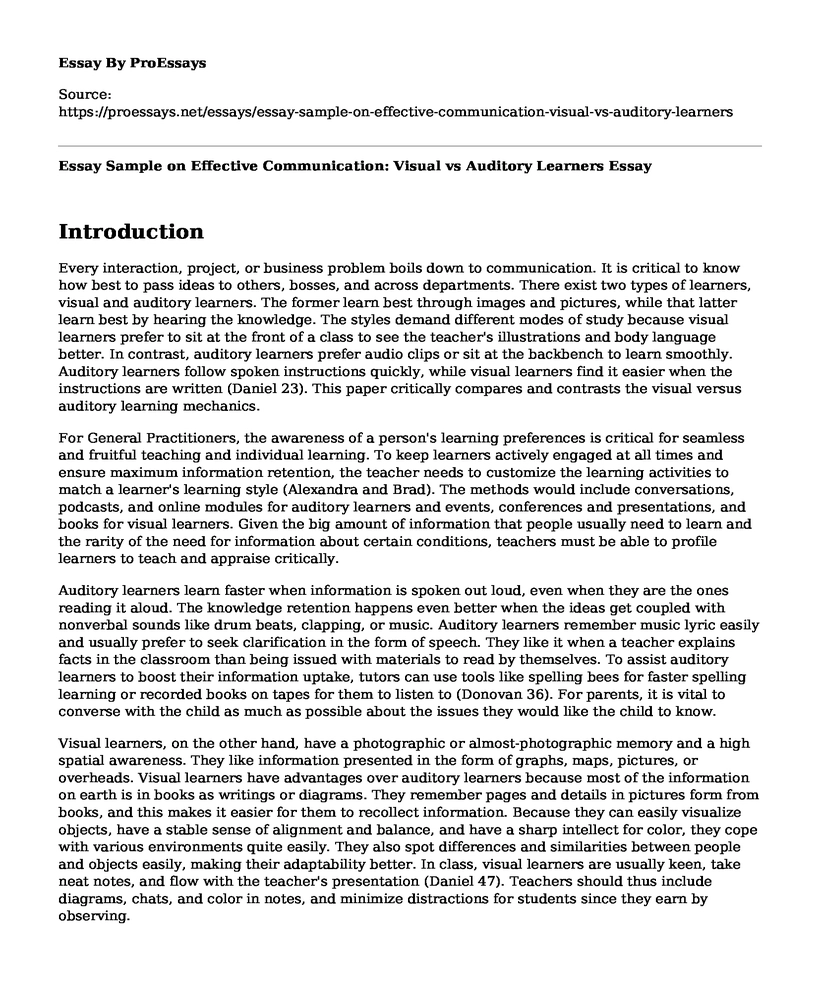Introduction
Every interaction, project, or business problem boils down to communication. It is critical to know how best to pass ideas to others, bosses, and across departments. There exist two types of learners, visual and auditory learners. The former learn best through images and pictures, while that latter learn best by hearing the knowledge. The styles demand different modes of study because visual learners prefer to sit at the front of a class to see the teacher's illustrations and body language better. In contrast, auditory learners prefer audio clips or sit at the backbench to learn smoothly. Auditory learners follow spoken instructions quickly, while visual learners find it easier when the instructions are written (Daniel 23). This paper critically compares and contrasts the visual versus auditory learning mechanics.
For General Practitioners, the awareness of a person's learning preferences is critical for seamless and fruitful teaching and individual learning. To keep learners actively engaged at all times and ensure maximum information retention, the teacher needs to customize the learning activities to match a learner's learning style (Alexandra and Brad). The methods would include conversations, podcasts, and online modules for auditory learners and events, conferences and presentations, and books for visual learners. Given the big amount of information that people usually need to learn and the rarity of the need for information about certain conditions, teachers must be able to profile learners to teach and appraise critically.
Auditory learners learn faster when information is spoken out loud, even when they are the ones reading it aloud. The knowledge retention happens even better when the ideas get coupled with nonverbal sounds like drum beats, clapping, or music. Auditory learners remember music lyric easily and usually prefer to seek clarification in the form of speech. They like it when a teacher explains facts in the classroom than being issued with materials to read by themselves. To assist auditory learners to boost their information uptake, tutors can use tools like spelling bees for faster spelling learning or recorded books on tapes for them to listen to (Donovan 36). For parents, it is vital to converse with the child as much as possible about the issues they would like the child to know.
Visual learners, on the other hand, have a photographic or almost-photographic memory and a high spatial awareness. They like information presented in the form of graphs, maps, pictures, or overheads. Visual learners have advantages over auditory learners because most of the information on earth is in books as writings or diagrams. They remember pages and details in pictures form from books, and this makes it easier for them to recollect information. Because they can easily visualize objects, have a stable sense of alignment and balance, and have a sharp intellect for color, they cope with various environments quite easily. They also spot differences and similarities between people and objects easily, making their adaptability better. In class, visual learners are usually keen, take neat notes, and flow with the teacher's presentation (Daniel 47). Teachers should thus include diagrams, chats, and color in notes, and minimize distractions for students since they earn by observing.
The two types are leaning are mostly complementary. Teachers who incorporate both traits of visual and auditory learning in teaching often yield the best class performance. Combining the techniques enable learners to construe and add value to information quickly and to stay open to new information.
Works Cited
Rolfe, Alexandra, and Cheek, Brad. "Learning Styles." InnovAiT, vol. 5, no. 3, SAGE Publications, Mar. 2012, pp. 176-81, doi:10.1093/innovait/inr239.
Walling, Donovan R. Teaching Writing to Visual, Auditory, and Kinesthetic Learners. Thousand Oaks, Calif: Corwin Press, 2006. Print.
Willingham, Daniel T. The Reading Mind: A Cognitive Approach to Understanding How the Mind Reads. , 2017. Print.
Cite this page
Essay Sample on Effective Communication: Visual vs Auditory Learners. (2023, Mar 25). Retrieved from https://proessays.net/essays/essay-sample-on-effective-communication-visual-vs-auditory-learners
If you are the original author of this essay and no longer wish to have it published on the ProEssays website, please click below to request its removal:
- Ethical Theories Paper Example
- Divorce and the Groups More Likely to Divorce Essay
- Essay Sample on the Impact of the Internet in Society
- Paper Example on Mentoring African-American Male Youth in South Carolina: Examining Perceptions
- Paper Example on Domestic Violence: Injuries, Control, and Children Affected
- Paper Example on Age-Related Changes: Nutritional Challenges & Health Risks
- Meaning of Freedom From Justice Kennedy - Essay Sample







